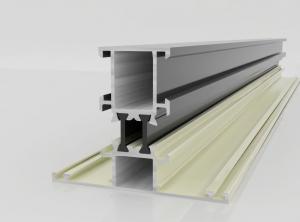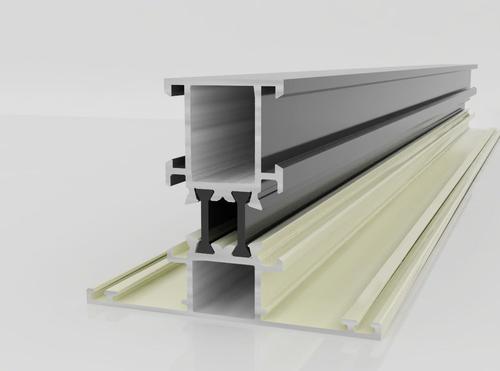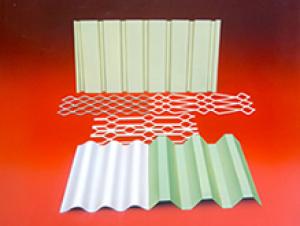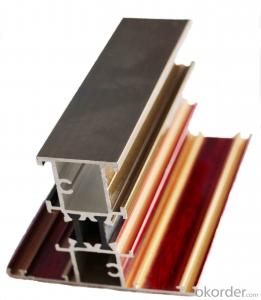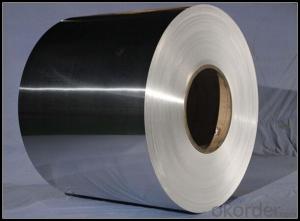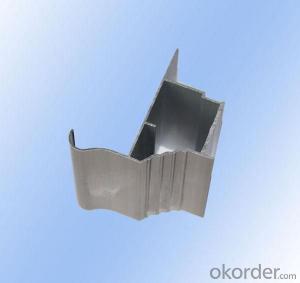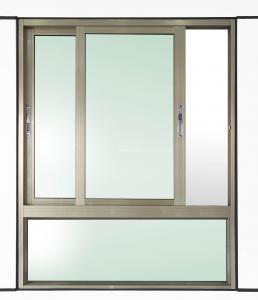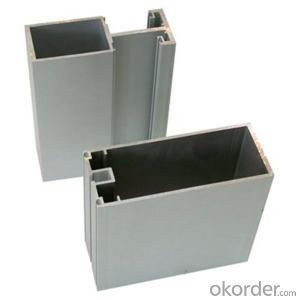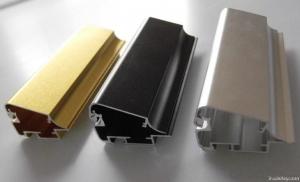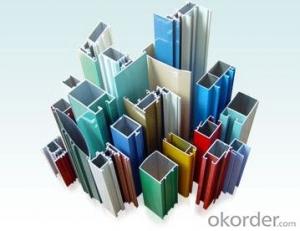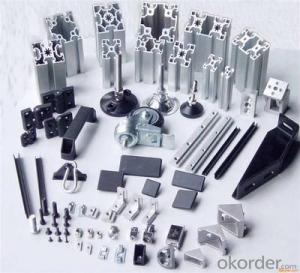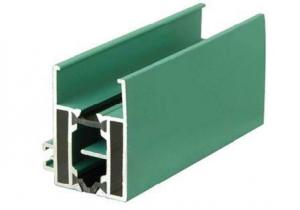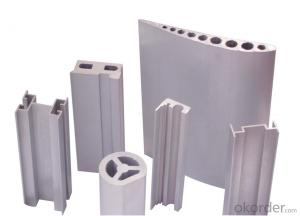Customized Colorful Powder Coating Aluminum Door Profile AA6063
- Loading Port:
- China Main Port
- Payment Terms:
- TT OR LC
- Min Order Qty:
- -
- Supply Capability:
- -
OKorder Service Pledge
OKorder Financial Service
You Might Also Like
Powder Coating Aluminum door profile of - AA6060
1) Material : 6063 6061 6060 and different aluminium alloy
2) Alloy Temper: T4 T5 T6 or other special status as per customer's needing.
3) Optional Surface treatment: mill finish, anodized sliver ,anodized bronze, anodized champagne, anodized black pearl, various power coating color, electrophoretic sliver, electrophoretic champagne, electrophoretic golden,
electrophoretic titanium, machine polish sliver, machine polish bronze, wooden grain color, and Fluorocarbon spraying.
4) Annual capacity : 120000TON
5) Quality : China Nation Standard GB/T 5237 2004 (advanced class)
6) Application: can be widely used for aluminium window, door, curtain wall, hand railing ,
normal aluminium profiles, decoration and industrial aluminium profiles.
7) Advantage: Famous Brand reasonable&market price, soonest delivery and good after sale- service
- Q: Are aluminum profiles suitable for protective enclosures?
- Protective enclosures can be constructed using aluminum profiles, as they are lightweight, strong, and durable. This material is suitable for both indoor and outdoor applications due to its resistance to corrosion, UV rays, and extreme weather conditions. Moreover, aluminum profiles can be easily customized to meet specific enclosure requirements in terms of size, shape, and design. Additionally, the non-magnetic properties of aluminum are beneficial in applications where reducing magnetic interference is necessary. Thus, aluminum profiles offer a dependable and cost-effective solution for building protective enclosures in industries like electronics, telecommunications, automotive, and others.
- Q: Can aluminum profiles be used in electrical panel manufacturing?
- Yes, aluminum profiles can be used in electrical panel manufacturing. Aluminum is a lightweight and durable material that offers excellent electrical conductivity, making it suitable for use in electrical panels. It also has good heat dissipation properties, which is important for preventing overheating in electrical systems. Aluminum profiles can be easily fabricated and customized to meet the specific requirements of electrical panel designs. Additionally, aluminum is resistant to corrosion, which ensures the longevity of the electrical panel. Overall, aluminum profiles are a popular choice in electrical panel manufacturing due to their numerous benefits.
- Q: This question asks for a comparison between aluminum profiles and other materials regarding their visual appeal and aesthetic qualities.
- <p>Aluminum profiles are often favored for their sleek, modern appearance and high aesthetic value. They offer a clean, silvery finish that can be anodized or painted to match various design schemes. Compared to materials like wood, they provide a contemporary look, while their uniformity and precision in manufacturing can surpass the natural variations found in wood. When compared to plastics, aluminum profiles offer a more premium feel and are often perceived as more durable and high-quality. Additionally, aluminum's recyclability and low maintenance requirements contribute to its eco-friendly and aesthetic appeal in sustainable design.</p>
- Q: Are aluminum profiles suitable for use in the mining industry?
- The mining industry can benefit greatly from the use of aluminum profiles. Aluminum, known for its lightweight yet strong and durable qualities, offers numerous advantages in mining applications. One crucial advantage of aluminum profiles lies in their exceptional resistance to corrosion. In the mining industry, where equipment often faces harsh environmental conditions and exposure to chemicals, this corrosion resistance is vital. Aluminum profiles can endure moisture, chemicals, and other corrosive substances without deteriorating, ensuring long-lasting performance and minimizing maintenance costs. Another perk of aluminum profiles is their impressive strength-to-weight ratio. Compared to other metals commonly used in mining equipment, such as steel, aluminum is significantly lighter. This lightweight characteristic makes aluminum profiles easier to handle, transport, and install, resulting in saved time and reduced labor costs. Despite being lightweight, aluminum profiles are still robust enough to withstand the demanding conditions of the mining industry, making them a reliable choice for various applications. Furthermore, aluminum profiles offer excellent thermal conductivity. This property proves advantageous in mining operations involving heat-generating machinery or processes. Aluminum profiles efficiently dissipate heat, preventing equipment overheating and enhancing overall safety and productivity. Moreover, aluminum is a non-magnetic material, making it ideal for mining operations that require non-magnetic equipment. This characteristic ensures that aluminum profiles will not interfere with sensitive equipment or disrupt magnetic fields, maintaining the accuracy and reliability of mining processes. In summary, aluminum profiles are highly suitable for the mining industry due to their corrosion resistance, high strength-to-weight ratio, thermal conductivity, and non-magnetic properties. Integrating aluminum profiles into mining equipment can improve performance, reduce maintenance costs, and enhance overall efficiency in various mining applications.
- Q: How do aluminum profiles contribute to sustainable infrastructure development?
- Aluminum profiles play a significant role in promoting sustainable infrastructure development in various ways. Firstly, aluminum is a lightweight material, which means it requires less energy during transportation and installation compared to other heavy materials like steel. This reduces greenhouse gas emissions and the overall carbon footprint associated with construction projects. Additionally, aluminum profiles have excellent durability and corrosion resistance, allowing them to withstand harsh environmental conditions and extend the lifespan of infrastructure projects. This durability reduces the frequency of repairs and replacements, leading to reduced waste generation and resource consumption. Furthermore, aluminum is a highly recyclable material, with the ability to be infinitely recycled without losing its original properties. This promotes a circular economy by minimizing the need for primary aluminum production and reducing the demand for raw materials. The recycling process of aluminum also requires significantly less energy compared to primary production, resulting in reduced energy consumption and lower emissions. Moreover, aluminum profiles offer design flexibility and compatibility with various construction methods, allowing for innovative and sustainable infrastructure solutions. They can be easily integrated into energy-efficient systems, such as solar panels or LED lighting, to further enhance sustainability. Overall, the use of aluminum profiles in infrastructure development contributes to a more sustainable built environment by reducing energy consumption, minimizing waste generation, promoting recycling, and enabling the implementation of energy-efficient solutions.
- Q: What are aluminum profiles used for?
- Aluminum profiles are used for a wide range of applications across various industries. One of the primary uses of aluminum profiles is in construction and architecture. They are commonly used in the framing of windows, doors, and curtain walls due to their lightweight yet sturdy nature. Aluminum profiles are also used in the construction of modular structures, such as exhibition stands, trade show booths, and temporary shelters. In the automotive industry, aluminum profiles are utilized for manufacturing components such as vehicle frames, roof rails, and trim parts. The lightweight properties of aluminum make it an ideal choice for improving fuel efficiency and reducing overall vehicle weight. Another significant application of aluminum profiles is in the production of industrial machinery and equipment. These profiles are used for constructing machine frames, conveyor systems, and assembly lines. The versatility of aluminum profiles allows for easy customization and modification to meet specific industrial requirements. Additionally, aluminum profiles find extensive use in the manufacturing of furniture and interior design. They are widely employed for constructing shelving units, workstations, display cabinets, and partitions due to their aesthetics, durability, and corrosion resistance. Furthermore, aluminum profiles are extensively used in the electrical and electronics industry. They are used for manufacturing heat sinks, enclosures, and mounting brackets. The excellent thermal conductivity of aluminum helps dissipate heat effectively, making it an ideal choice for electronic devices. Overall, the versatility, lightweight nature, corrosion resistance, and ease of customization make aluminum profiles highly sought after in numerous industries, offering a wide range of applications in construction, automotive, machinery, furniture, and electronics sectors.
- Q: How to process the wood grain transfer of aluminum profile? Thank you
- Popular talk is to transfer grain, electrostatic powder coating on metal material, vacuum equipment through the wood grain transfer on the coating material in high temperature, pay pressure, ink sublimation transfer printing or transfer film on the penetration into a conversion process in the coating. Now there are very good equipment in China ~!
- Q: Explain the positive environmental impacts of utilizing recycled aluminum in the construction industry.
- <p>Using recycled aluminum in construction offers significant environmental benefits. It conserves natural resources by reducing the need for mining new bauxite, the primary source of aluminum. This reduction in mining decreases habitat destruction, water pollution, and soil erosion. Additionally, recycling aluminum saves energy, as it requires only 5% of the energy needed to produce aluminum from raw materials. This energy conservation leads to lower greenhouse gas emissions and air pollution. Moreover, the use of recycled aluminum reduces landfill waste, as less material ends up in landfills. Overall, it promotes a more sustainable and eco-friendly construction process.</p>
- Q: Can aluminum profiles be used in the production of transportation containers?
- Yes, aluminum profiles can be used in the production of transportation containers. Aluminum is a lightweight and durable material that is widely used in various industries, including transportation. It offers several advantages for container production, such as corrosion resistance, high strength-to-weight ratio, and ease of fabrication. Aluminum profiles can be used to construct the framework and walls of transportation containers, providing structural integrity while keeping the overall weight of the container low. Additionally, aluminum profiles can be easily customized and shaped to fit specific container requirements. Overall, the use of aluminum profiles in transportation container production offers numerous benefits and is a popular choice among manufacturers.
- Q: This question asks for a list of various fastening methods or components used to attach aluminum profiles in roofing systems.
- <p>In roofing systems, various types of fasteners are used to secure aluminum profiles, ensuring stability and longevity. Some common fasteners include: 1. Self-tapping screws, which thread directly into the aluminum without pre-drilling. 2. Rivets, which join two pieces of aluminum by compressing them together. 3. Nuts and bolts, used in conjunction with pre-drilled holes for a secure fit. 4. Clamps, which hold profiles together without penetrating the material. 5. Adhesives, used for bonding profiles in situations where mechanical fasteners are not suitable. 6. Clips and brackets, which can be used to attach profiles to other structural elements. Each type of fastener has its specific application and is chosen based on the design requirements and environmental conditions of the roofing system.</p>
Send your message to us
Customized Colorful Powder Coating Aluminum Door Profile AA6063
- Loading Port:
- China Main Port
- Payment Terms:
- TT OR LC
- Min Order Qty:
- -
- Supply Capability:
- -
OKorder Service Pledge
OKorder Financial Service
Similar products
Hot products
Hot Searches
Related keywords
